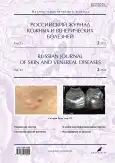Сlinical cases of newly diagnosed systemic lupus erythematosus at the appointment with a dermatologist
- Authors: Morozova E.A.1, Bausheva E.A.1
-
Affiliations:
- I.M. Sechenov First Moscow State Medical University (Sechenov University)
- Issue: Vol 25, No 2 (2022)
- Pages: 141-149
- Section: DERMATOLOGY
- URL: https://journal-vniispk.ru/1560-9588/article/view/108211
- DOI: https://doi.org/10.17816/dv108211
- ID: 108211
Cite item
Abstract
Lupus erythematosus is a multisystemic connective tissue disease that has a wide range of manifestations affecting the skin and mucous membranes, joints, kidneys, heart, lungs, and central nervous system. In dermatology, cutaneous forms of lupus erythematosus can be classified into discoid, disseminated, centrifugal erythema, lupus panniculitis, subacute and chronic lupus, and systemic lupus erythematosus with damage to internal organs. It can develop as an independent disease or can be a result of progression of cutaneous forms.
The skin is the second most commonly affected organ in systemic lupus erythematosus folowing the joints, with skin manifestations observed in 80% of patients throughout the course of the disease. And in 20−30% of cases, the disease debuts with skin rash. Thus, these patients primarily present to dermatologists. Knowledge of the criteria for making a diagnosis, the clinical characteristics, in combination with performance of advanced laboratory diagnostic tests allow a dermatologist to suspect a systemic process in a timely manner and prescribe appropriate therapy.
The article presents two clinical observations of male patients with systemic lupus erythematosus, the diagnosis of which could not have been established for several years. The diagnosis in these cases met the 2019 European League Against Rheumatism (EULAR) and the American College of Rheumatology (ACR) classification criteria for systemic lupus erythematosus, confirmed by laboratory tests. Patients had a positive trend to response to therapy.
Full Text
##article.viewOnOriginalSite##About the authors
Elena A. Morozova
I.M. Sechenov First Moscow State Medical University (Sechenov University)
Author for correspondence.
Email: doc.elene@mail.ru
ORCID iD: 0000-0001-5826-5018
SPIN-code: 4437-3800
MD, Cand. Sci. (Med.), Assistant
Russian Federation, MoscowEvgeniia A. Bausheva
I.M. Sechenov First Moscow State Medical University (Sechenov University)
Email: ea.bausheva@mail.ru
ORCID iD: 0000-0002-8067-1044
SPIN-code: 4575-9454
MD
Russian Federation, MoscowReferences
- Kang S, Amadai M, Bruckner AL, et al. Fitzpatrick’s dermatology. 9th ed. Vol. 1. McGraw-Hill Education; 2019. Р. 1037−1039.
- Olisova OY. Skin and venereal diseases. Moscow: Practical Medicine; 2015. Р. 186–192. (In Russ).
- Tlish MM, Naatyzh ZY, Sycheva NL, et al. Systemic lupus erythematosus: an interdisciplinary approach to the diagnosis. Russ J Skin Venereal Diseases. 2016;19(3):141−147. (In Russ). doi: 10.18821/1560-9588-2016-19-3-141-147
- Kubanov AA, Samtsov AV, Khayrutdinov VR, et al. Clinical guidelines. Lupus erythematosus. All-Russian Public Organization Russian Society of Dermatovenereologists and Cosmetologists; 2020. Р. 6–17. (In Russ).
- Tebbe B, Orfanos CE. Epidemiology and socioeconomic impact of skin disease in lupus erythematosus. Lupus. 1997;6(2):96−104. doi: 10.1177/096120339700600204
- Trofimov PN, Antonova OV, Shvyrev DN, et al. Cutaneous lupus erythematosus: pathogenesis, clinical pattern, diagnostics, therapy. Bulletin Dermatol Venereol. 2015;91(5):24−33. (In Russ). doi: 10.25208/0042-4609-2015-91-5-24-33
- Obermoser G, Sontheimer RD, Zelger B. Overview of common, rare and atypical manifestations of cutaneous lupus erythematosus and histopathological correlates. Lupus. 2010;19(9):1050−1070. doi: 10.1177/0961203310370048
- Ackermann AB. Lupus erythematosus. In: Histologic diagnosis of inflammatory skin diseases. Baltimore: Williams & Wilkins; 1997. Р. 525−546.
- Alekseeva EI, Dvoryakovskaya TM, Nikishina IP, et al. Systemic lupus erythematosus: clinical recommendations. Part 1. Questions Modern Pediatrics. 2018;17(1):19–37. (In Russ). doi: 10.15690/vsp.v17i1.1853
- Alekseeva EI, Dvoryakovskaya TM, Nikishina IP, et al. Systemic lupus erythematosus: clinical recommendations. Part 2. Questions Modern Pediatrics. 2018;17(2):110–125. (In Russ). doi: 10.15690/vsp.v17i2.1877
- Aringer M, Costenbader K, Daikh D, et al. 2019 European league against rheumatism / American college of rheumatology classification criteria for systemic lupus erythematosus. Arthritis Rheumatol. 2019;71(9):1400−1412. doi: 10.1002/art.40930
- Andrade RM, Alarcón GS, Fernández M, et al. Accelerated damage accrual among men with systemic lupus erythematosus: XLIV. Results from a multiethnic US cohort. Arthritis Rheum. 2007;56(2):622−630. doi: 10.1002/art.22375
- Fanouriakis A, Kostopoulou M, Alunno A, et al. 2019 update of the EULAR recommendations for the management of systemic lupus erythematosus. Ann Rheum Dis. 2019;78(6):736−745. doi: 10.1136/annrheumdis-2019-215089
- Lebedeva S, Teplyuk N, Belousova T, et al. Possibilities of external therapy of discoid red. Doctor. 2015;(2):49−51. (In Russ).
- Obermoser G, Sontheimer RD, Zelger B. Overview of common, rare and atypical manifestations of cutaneous lupus erythematosus and histopathological correlates. Lupus. 2010;19(9):1050−1070. doi: 10.1177/0961203310370048
- Rothfield N, Sontheimer RD, Bernstein M. Lupus erythematosus: systemic and cutaneous manifestations. Clin Dermatol. 2006;24(5):348−362. doi: 10.1016/j.clindermatol.2006.07.014
- Ribero S, Sciascia S, Borradori L, Lipsker D. The cutaneous spectrum of lupus erythematosus. Clin Rev Allergy Immunol. 2017;53(3):291−305. doi: 10.1007/s12016-017-8627-2
- Durosaro O, Davis MD, Reed KB, et al. Incidence of cutaneous lupus erythematosus, 1965−2005: a population-based study. Arch Dermatol. 2009;145(3):249−253. doi: 10.1001/archdermatol.2009.21
- Tlish MM, Naatyzh ZY, Sycheva NL, et al. Difficulties in the diagnosis of systemic lupus erythematosus. Russ J Skin Venereal Diseases. 2014;(3):36−41. (In Russ).
Supplementary files









